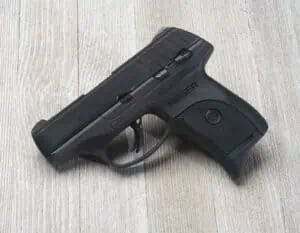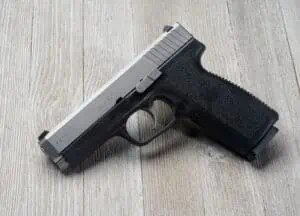Compact 9mm Pistols: The Last Word In Concealed Carry?
9mm pistols are nothing new. They’ve been around since Georg Luger upsized the 7.65×21 Parabellum round and used it in a pistol. Single stack magazines, where all the rounds are laid on top of one another, have been around for as long as we’ve had semi-automatic pistols. Compact pistols are nothing new either. They trace their origins back to some of the very first semi-automatic pistols. Finally, polymer-framed guns began to appear in the 1970s, and they now comprise a large portion of today’s market for concealed carry pistols.
What is fairly new, however, is putting all of those disparate elements together in one gun. The polymer-framed, single stack, compact 9mm pistol has been around for just a short time. The Kel-Tec PF9 was introduced in 2006, and the first version of the Ruger LC9 was rolled out in 2011. Since then, the small and thin polymer 9mm pistol has really taken off. Almost every major pistol manufacturer has some type of compact 9mm in their lineup, and more new models continue to be rolled out each year.
The compact 9mm pistol can be very effective if you know what it can and cannot do well and train accordingly. There are a number of features that make the compact 9mm an attractive option for concealed carry, especially when combined with a polymer frame and single-stack magazine.
Weight
The heavier a gun is, the harder it is to carry. The harder it is to carry, the less often we’ll carry it. There is a saying in the firearms community that a concealed carry gun should be comforting, not comfortable. While this is true to a certain extent, if a gun is not comfortable enough for daily carry, it will provide no comfort at all if it should be needed. All of the pistols we’ll be testing are significantly lighter than a full size service pistol, enhancing their usefulness as a concealed carry pistol.
Thinness
Thinner pistols are easier to conceal. A slim profile means your pistol is more comfortable to carry inside your waistband. It also means it won’t be as obvious when worn under a cover garment outside the waistband.
Let’s take a look at some of the drawbacks of these types of pistols.
Ammunition Capacity
For years, single-stack polymer compact 9mm pistols were known for carrying fewer rounds than larger guns. 7 rounds in a magazine was quite common, and 8 rounds seemed to be the upper limit. This is changing, though.
The Glock 48, for instance, holds ten rounds in a magazine. Fewer rounds, to be certain, than its larger cousin the Glock 19, but more than many other concealed carry guns. Another gun in our tests, the Sig Sauer P365, is more of a double-stack gun. However, it’s as slim as the other guns in our test. It holds ten rounds as well, with 12 and even 15 round extended magazines available from the factory.
Size
The small size of a compact 9mm works wonders when it’s time to conceal your gun. However, that small size can work against you as well. A short, thin grip means your hands don’t have as much to hold on to as larger guns, which means these guns are going to be harder to control under rapid fire. Speaking of recoil, their lighter weight is going to provide less mass to help dampen the movement of the gun. Add in the fact that the human hand works best when grabbing cylindrical objects, not flat ones, and what once was an easy task (accurate rapid fire) becomes much more difficult with a single-stack polymer gun.
Now let’s look at the guns we’ll be testing.
 Taurus G2s
Taurus G2s
Taurus has been making compact 9mm single stack pistols for a while now, and the G2s is their latest model. The G2s has many features that shooters want, yet they are still reasonably-priced. This makes them a popular option for many gun owners.
 Ruger EC9s
Ruger EC9s
Ruger was one of the first movers in the single stack 9mm market. They have recently tweaked their polymer 9mm single stack line that started with the LC9 (the LC380’s bigger brother). The new EC9s is a striker-fired gun, rather than hammer-fired like the LC9, and has a slim profile and many nice features.
 Walther PPS M2
Walther PPS M2
Walther is known for making easily concealable pistols that pack a punch. They were another of the first movers in the compact 9mm pistol market. Walther rolled out the original PPS in 2007. The PPS M2 is their latest model. It has three different options for magazine capacity, comfortable ergonomics, and a first-class trigger.
 Kel-Tec PF-9
Kel-Tec PF-9
Kel-Tec is one of the most innovative gun manufacturers out there right now. The PF-9 exemplifies their ability to create new guns that define a market. Released in 2006, the PF-9 holds seven rounds and is smaller and lighter than the other guns in our test.
 Kahr CT-9
Kahr CT-9
Kahr made their reputation by making quality compact pistols in a variety of calibers. The 9mm CT-9 shows that reputation is well-deserved. Slightly taller than most guns in our test, it is a solid performer that is comfortable in the hands.
 Smith & Wesson M&P Shield 2.0
Smith & Wesson M&P Shield 2.0
The single-stack polymer compact 9mm market really took off with the introduction of the first version of the Shield and the Ruger LC9. We’ll be reviewing the updated 2.0 model of the Shield, which we compared to the 1.0 model in a previous article.
 Mossberg MC1sc
Mossberg MC1sc
Mossberg is known mostly for shotguns and rifles. The MC1sc was a surprise reveal at the 2019 SHOT Show. Full-featured and easily upgradeable with a wide range of available accessories, it was one of the guns we chose as a best buy for your money.
 Sig Sauer P365
Sig Sauer P365
The best-selling handgun of 2018, the Sig Sauer P365 rewrote the rulebook when it came to this market niche. Packing 10+1 rounds into a gun this size, with a 12-round magazine available as well, it changed our perception of what a compact 9mm could do.
 Glock 48
Glock 48
For many people, the Glock 19 is the standard by which all other concealed carry guns are judged. The Glock 48 takes that standard and slims it down into a thinner size, giving you a smaller package with 10+1 9mm round punch.
 Beretta APX Carry
Beretta APX Carry
Beretta is the world’s oldest gunmaker, and their striker-fired APX line is the state of the art is one of their latest offerings. The APX Carry is an ultra-compact single-stack 9mm that is the smallest gun in the APX lineup, yet it still delivers full-sized features such as replacement grip frames and excellent sights.
Review and Testing Procedure
We’ll be comparing these guns in three different ways.
- Their physical features and price. Is one gun noticeably skinnier than the others? How many rounds do they hold? How much effort does it take to pull the trigger on each of them? Are any of them real bargains?
- Accuracy and reliability. We’ll be shooting 300 rounds of various kinds of ammunition through each gun. The ammunition we’ll be testing in each is:
- 100 Rounds of American Eagle 115 grain FMJ
- 100 Rounds of Wolf 115 grain FMJ
- 55 Rounds of Fiocchi 124 grain FMJ
- 25 Rounds of 135 grain Hornady Critical Duty JHP
- 20 Rounds of Federal 147 grain HST JHP
We will test the accuracy of each gun by firing four five-shot groups of the American Eagle, Wolf, and HST rounds from a rest from 15 yards. We will also measure the velocity of these rounds from our test guns.
- Ergonomics and operation. What does it feel like to shoot each gun? Are the controls where you expect them to be? Does one gun handle recoil better than the others?
Is the Polymer Frame Compact 9mm Single Stack The Last Word In Concealed Carry?
I’m tempted to answer “yes” to that question. Since 2012, I’ve used a Smith & Wesson M&P Shield as my primary concealed carry gun. It’s a polymer, single stack (ok, stack-and-a-halfish) compact 9mm pistol. I’ve been very happy with how this pistol has performed over the years. I’ve practiced with it, competed with it in practical pistol matches, and taken it to a number of different training classes. I’m at the point now where I can now not only reliably shoot the FBI Pistol Qualification with my Shield, but pass at the Instructor Level as well.
However, I know that a larger gun, such as an M&P Compact, offers some distinct advantages like ammunition capacity over my Shield. The fact is, though, that I can carry my Shield much more comfortably on a day in, day out basis than a larger gun. I’ve put in the time to make my Shield an effective defensive firearm, because the best gun you can have when you need one is the one you have right at that moment.



Sorry, noticed you did point out the P365 isn’t technically a single stack. I didn’t catch that note at first. It sure is thin though.